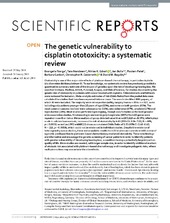| dc.Published | Tserga, Nandwani, Edvall NK, Bulla J, Patel P, Canlon B, Cederroth CR, Baguley. The genetic vulnerability to cisplatin ototoxicity: a systematic review. Scientific Reports. 2019;9:3455 | eng |
| dc.description.abstract | Ototoxicity is one of the major side-effects of platinum-based chemotherapy, in particular cisplatin (cis-diammine dichloroplatinum II). To our knowledge, no systematic review has previously provided a quantitative summary estimate of the impact of genetics upon the risk of developing hearing loss. We searched Embase, Medline, ASSIA, Pubmed, Scopus, and Web of Science, for studies documenting the genetic risk of ototoxicity in patients with cancer treated with cisplatin. Titles/abstracts and full texts were reviewed for inclusion. Meta-analytic estimates of risk (Odds Ratio) from the pooled data were calculated for studies that have been repeated twice or more. The search identified 3891 papers, of which 30 were included. The majority were retrospective (44%), ranging from n = 39 to n = 317, some including only patients younger than 25 years of age (33%), and some on both genders (80%). The most common cancers involved were osteosarcoma (53%), neuroblastoma (37%), prostate (17%) and reproductive (10%). Most studies performed genotyping, though only 5 studies performed genome-wide association studies. Nineteen single-nucleotide polymorphisms (SNPs) from 15 genes were repeated more than twice. Meta-analysis of group data indicated that rs1872328 on ACYP2, which plays a role in calcium homeostasis, increases the risk of ototoxicity by 4.61 (95% CI: 3.04–7.02; N = 696, p < 0.0001) as well as LRP2 rs4668123 shows a cumulated Odds Ratio of 3.53 (95% CI: 1.48–8.45; N = 118, p = 0.0059), which could not be evidenced in individual studies. Despite the evidence of heterogeneity across studies, these meta-analytic results from 30 studies are consistent with a view of a genetic predisposition to platinum-based chemotherapy mediated ototoxicity. These new findings are informative and encourage the genetic screening of cancer patients in order to identify patients with greater vulnerability of developing hearing loss, a condition having a potentially large impact on quality of life. More studies are needed, with larger sample size, in order to identify additional markers of ototoxic risk associated with platinum-based chemotherapy and investigate polygenic risks, where multiple markers may exacerbate the side-effects. | en_US |

